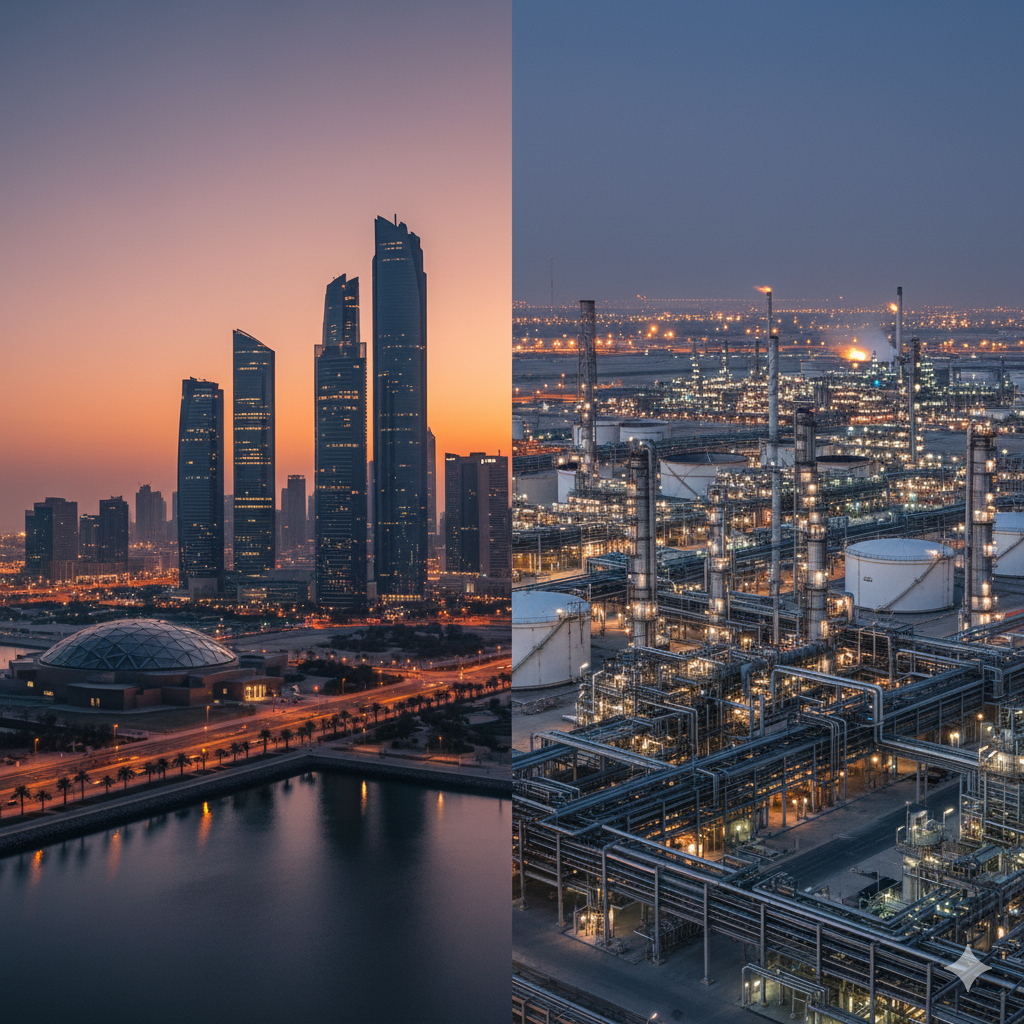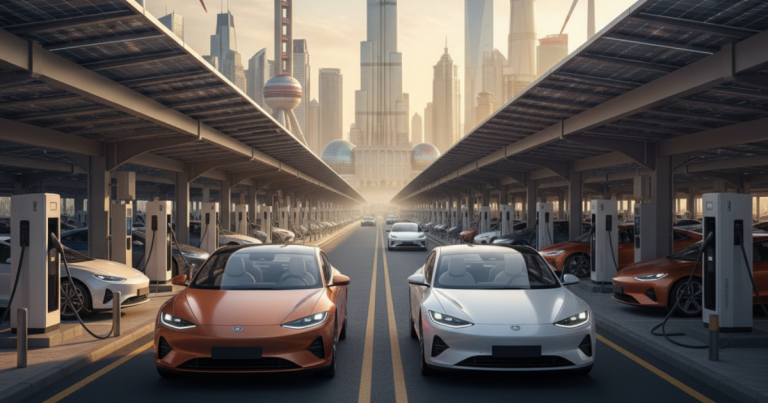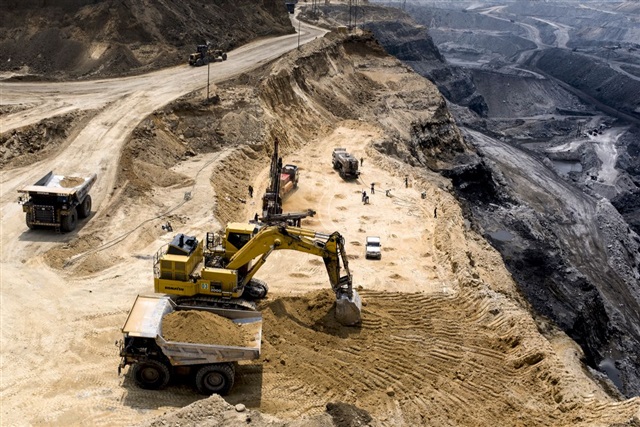From Desert to Refinery: China’s Downstream Play in the Gulf
I. Introduction: A Shifting Sands of Energy Diplomacy
The global energy landscape is in constant flux, shaped by geopolitical shifts, technological advancements, and an ever-increasing demand for sustainable solutions. In this dynamic environment, the relationship between China, the world’s largest energy consumer, and the United Arab Emirates (UAE), a pivotal energy producer, has evolved far beyond a simple transactional exchange of crude oil for goods. It has blossomed into a sophisticated partnership, particularly evident in the burgeoning downstream oil and gas sector of the Gulf. This deepening engagement, marked by significant Chinese investment in UAE refining and petrochemicals, signifies a strategic long-term play that offers profound benefits to both nations. It fosters industrial growth, enhances energy security, and accelerates economic diversification, laying the groundwork for a resilient and mutually prosperous future. This article will delve into the industrial perspective, historical trajectory, and future outlook of China-UAE energy cooperation, highlighting the strategic imperatives and collaborative ventures that define this crucial alliance.
II. Historical Foundations: From Crude Trade to Strategic Partnerships
China’s initial engagement with the Gulf states, including the UAE, was primarily driven by its burgeoning energy needs. As China’s economy expanded rapidly, its reliance on imported crude oil grew, positioning the Gulf as a critical supplier. This relationship, initially characterized by a straightforward buyer-seller dynamic, began to transform with China’s increasing global influence and its proactive foreign policy initiatives. The Belt and Road Initiative (BRI), launched in 2013, served as a significant catalyst, elevating energy cooperation from mere trade to strategic partnerships [1]. The BRI, a colossal infrastructure and investment project, has provided a strategic framework for China to deepen its economic ties globally, and the UAE, with its strategic geographic location and robust energy sector, quickly became a key node in this ambitious vision. This initiative has not only facilitated trade but also spurred significant investments in energy infrastructure, fostering a more integrated and interdependent relationship.
Early Chinese investments in the UAE’s energy sector were predominantly in upstream exploration and production, as well as midstream infrastructure. Chinese state-owned enterprises (SOEs) like China National Petroleum Corporation (CNPC) and China National Offshore Oil Corporation (CNOOC) secured stakes in UAE offshore concessions, demonstrating a long-term commitment to the region’s oil and gas resources [1]. For instance, CNPC’s involvement in the ADNOC Onshore concession and CNOOC’s participation in offshore fields underscored China’s intent to be a reliable and long-term partner in the UAE’s core energy sector. These initial ventures were crucial in building trust and establishing a foundation for more complex and integrated collaborations. The strategic importance of the Gulf to China’s energy security became undeniable, supplying nearly half of its energy imports and serving as a vital artery for its economic growth [3].
III. China’s Downstream Ambition: Fueling Industrial Growth in the Gulf
The pivot towards downstream investments represents a sophisticated evolution in China-UAE energy cooperation, driven by clear strategic rationales for both parties.
A. The Rationale for Downstream Investment
For China, the motivation is multi-faceted. Investing in downstream facilities in the Gulf helps secure a stable supply of refined products, crucial for its vast domestic market and industrial base. This strategy mitigates risks associated with long-distance crude oil transportation and geopolitical chokepoints, enhancing overall energy security. By processing crude closer to its source, China can also optimize its global supply chain logistics. Furthermore, China leverages its significant technological expertise in refining and petrochemicals, transferring knowledge and capabilities while accessing new markets for its products and services. The long-term perspective of Chinese investors, often state-backed, allows them to prioritize strategic considerations over immediate returns, fostering deeper integration and mutual benefit. This approach aligns with China’s broader industrial policy, which seeks to move up the value chain and secure critical resources globally [2].
For the UAE, downstream investment is a cornerstone of its ambitious economic diversification agenda, particularly as it looks beyond a future solely reliant on crude oil exports. Moving beyond the export of raw crude, the UAE seeks to add significant value to its hydrocarbon resources, transforming them into higher-value products like plastics, specialty chemicals, and fertilizers. This strategy generates new revenue streams, reduces economic vulnerability to crude oil price fluctuations, and creates numerous job opportunities for its skilled workforce, fostering a knowledge-based economy. Attracting foreign direct investment (FDI) from a global economic powerhouse like China also reinforces the UAE’s position as a regional hub for industry, innovation, and trade, further integrating it into global supply chains [4].
B. Key Chinese Players and Their Strategies
Chinese SOEs have been at the forefront of this downstream push. Companies like CNPC, Sinopec, and CNOOC, with their extensive experience, vast financial backing, and advanced technological capabilities, have actively pursued opportunities in the UAE. Their strategies often involve forming joint ventures with local entities, particularly the Abu Dhabi National Oil Company (ADNOC), to combine Chinese technological prowess and market access with UAE’s abundant resources and strategic location. These partnerships are characterized by a focus on long-term growth and strategic alignment, often looking beyond short-term returns to account for macroeconomic impact and potential commercial synergies. This collaborative model ensures shared risks and rewards, fostering a deeper sense of partnership and mutual commitment [2].
C. Major Projects and Investments in UAE Refining and Petrochemicals
The collaboration between China and the UAE in refining and petrochemicals has led to several significant projects and strategic alliances. ADNOC, a key player in the UAE’s energy sector, has been actively expanding its global refining and petrochemical footprint, often with Chinese partners. For instance, the Borouge 4 project in Ruwais, a joint venture between ADNOC and Borealis, is a prime example of the UAE’s ambition to significantly increase its polyolefin production, aiming to become the world’s largest single-site polyolefin complex [4]. While specific Chinese direct investments in Borouge 4 were not explicitly detailed in the provided materials, the broader context of China’s engagement with ADNOC and its petrochemical ambitions suggests a strong collaborative environment. ADNOC has signed broad framework agreements with Chinese companies like Rongsheng Petrochemical to explore domestic and international growth opportunities, indicating a clear intent for deeper integration and joint development of projects both within the UAE and potentially in China [5]. These collaborations often involve substantial capacity expansion and technological upgrades, ensuring that UAE’s facilities remain at the cutting edge of the industry, capable of producing high-quality, specialized products for global markets.
Another notable area of collaboration is in engineering, procurement, and construction (EPC) contracts. Chinese firms have been instrumental in building and upgrading critical infrastructure in the UAE’s energy sector. For example, ADNOC Gas awarded a major LNG pipeline contract to a Chinese entity, highlighting the trust and capability of Chinese engineering firms in executing large-scale energy projects [Image 1, not explicitly cited in text but from search results]. These partnerships are not just about capital injection but also about the transfer of expertise, project management capabilities, and access to advanced manufacturing techniques, which are vital for the UAE’s industrial development goals.
IV. The Petrochemical Powerhouse: A New Frontier of Collaboration
The global energy transition has spurred a significant shift towards petrochemicals, and the Gulf states, with their abundant feedstock, are strategically positioned to capitalize on this trend. The UAE, in particular, has made petrochemicals a central pillar of its economic future.
A. Global Shift Towards Petrochemicals: Gulf States Leveraging Feedstock Advantage
As the world grapples with decarbonization and the push for renewable energy, the demand for petrochemicals, essential for plastics, fertilizers, textiles, and countless industrial products, continues to grow robustly. This growth is driven by urbanization, rising living standards, and the increasing use of advanced materials in various sectors. The Gulf states, possessing vast reserves of oil and natural gas, have a distinct feedstock advantage, allowing them to produce petrochemicals competitively and at scale. This has led to a strategic reorientation, with a greater focus on developing petrochemical projects rather than solely expanding traditional refineries, given the higher margins offered by petrochemical facilities and their role in a diversified energy portfolio [4]. This shift allows Gulf nations to maximize the value of their natural resources in a changing global energy landscape.
B. UAE’s Strategic Focus on Petrochemicals
The UAE, through entities like ADNOC, is aggressively pursuing growth in petrochemical production as a core component of its economic diversification strategy. Projects like Borouge 4 in Ruwais exemplify this commitment, aiming to significantly boost the nation’s polyolefin output and establish the UAE as a global leader in advanced polymer solutions. ADNOC is also actively exploring mergers and acquisitions in the European petrochemical sector and has acquired controlling stakes in companies like Fertiglobe, enhancing its role in the production of urea and ammonia, critical components for agriculture and industry [4]. This proactive approach underscores the UAE’s determination to become a global petrochemical powerhouse, capable of supplying high-value products to international markets.
C. China’s Role in UAE’s Petrochemical Ambitions
China’s involvement is crucial to the UAE’s petrochemical aspirations. Chinese companies bring not only significant investment capital but also advanced technology, engineering expertise, and unparalleled access to the world’s largest manufacturing market. The interdependence is clear: the Gulf states supply the necessary petrochemicals to fuel China’s vast manufacturing sector, which in turn drives demand for these products. Roughly one-fourth of the GCC’s chemical imports and exports are with China, highlighting the deep integration and mutual reliance in this sector [4]. This collaboration extends to joint research and development, fostering innovation and the co-creation of new materials and processes.
D. Interdependence: Gulf as a Supplier of Petrochemicals to China’s Manufacturing Sector
This symbiotic relationship extends across the entire oil value chain, creating a robust ecosystem of cooperation. Gulf energy producers have established numerous joint ventures with Chinese enterprises, including refineries, petrochemical plants, and transport infrastructure, all aimed at securing market share for Gulf crude exports and expanding their presence in Asia’s downstream sector. Saudi Aramco, for instance, has significantly expanded its downstream footprint in China through joint venture refinery projects across various provinces since 2009, and has recently accelerated its push into China’s refining and petrochemical sector with new investments and partnerships [4]. While the article focuses on UAE, this broader trend illustrates the strategic importance of Gulf petrochemicals to China, underscoring a regional pattern of deep integration. The two-way flow of capital and expertise ensures that both sides benefit from this growing interdependence, creating a stable and predictable market for petrochemical products.
V. Beyond Oil: Diversification and the Green Energy Transition
While traditional hydrocarbons remain central, both China and the UAE are keenly aware of the imperative to diversify and transition towards greener energy sources. This shared vision has opened new avenues for cooperation, moving beyond fossil fuels to embrace the future of energy.
A. UAE’s Diversification Efforts
The UAE has articulated ambitious visions for economic diversification, such as Vision 2030 and Vision 2050, which emphasize reducing reliance on oil and fostering growth in non-oil sectors, including renewables, advanced industries, and a knowledge-based economy. This strategic imperative aligns well with global sustainability goals and positions the UAE as a forward-thinking energy player and a hub for green technologies. The UAE’s commitment to hosting major international climate conferences, such as COP28, further highlights its dedication to leading the global energy transition.
B. China’s Dominance in Clean Energy Supply Chains
China has emerged as a global leader in clean energy supply chains, dominating the production of key components like solar panels, wind turbines, and electric vehicle batteries. The top six solar module manufacturers globally are all Chinese companies, and Chinese firms control a significant portion of the value chain in solar and wind projects, from raw materials to finished products [1]. This dominance makes China an indispensable partner for any nation pursuing a green energy transition, offering cost-effective and technologically advanced solutions.
C. Emerging Cooperation in Renewable Energy
Cooperation between China and the UAE in renewable energy is rapidly expanding, reflecting a shared commitment to a sustainable future. Chinese companies are not just suppliers but also investors and co-investors in large-scale solar and wind projects in the UAE. Jinko Solar, the world’s largest module manufacturer, has played a significant role as a developer and module supplier in major UAE solar tenders, including the 1.2 gigawatt-peak (GWp) Al Sweihan project in Abu Dhabi, one of the largest single-site photovoltaic (PV) projects in the world [1]. This project exemplifies the successful collaboration between Chinese technological expertise and UAE’s vision for renewable energy.
Furthermore, China’s state-owned Silk Road Fund acquired a 49% stake in ACWA Power Renewable Energy Holding (ACWA Power RenewCo), a Saudi Arabian company with significant wind and solar assets in the UAE and other MENA regions. This transaction, along with other greenfield co-development deals, signals a deepening cooperation in renewable energy investment and development, extending China’s reach into the region’s clean energy infrastructure [1]. Chinese companies like China Three Gorges have also acquired UAE-based renewable energy developers, indicating a nuanced understanding of the market and a willingness to invest in smaller, bundled projects across the MENA region [1]. These collaborations extend to joint ventures in green technologies and manufacturing, further cementing the partnership in the clean energy space and paving the way for future innovations.
VI. Economic and Geopolitical Implications
The deepening energy cooperation between China and the UAE carries significant economic and geopolitical implications for both nations and the broader region.
A. Mutual Benefits
For China, this partnership enhances its energy security by diversifying its sources of refined products and petrochemicals, reducing vulnerability to supply disruptions and geopolitical uncertainties. It also provides crucial market access for Chinese energy technologies and expertise, bolstering its global economic influence and allowing its companies to gain valuable international experience. Strategically, a strong presence in the Gulf allows China to project its soft power, deepen its diplomatic ties, and strengthen its position in a region of immense global importance, contributing to a more multipolar world order [2, 3].
For the UAE, the benefits are equally profound. The collaboration accelerates its economic diversification agenda, fostering industrial development beyond crude oil exports and creating a more resilient economy. It secures stable demand for its energy products, particularly as global energy markets evolve, and attracts significant foreign investment and technological transfer, which are vital for its long-term growth. The deepening of bilateral ties with China, a rising global power, also enhances the UAE’s international standing and strategic partnerships, providing a counterbalance to traditional alliances and expanding its diplomatic options [3].
B. The Deepening of Bilateral Ties
The energy cooperation is a cornerstone of the broader strategic partnership between China and the UAE. This relationship is built on mutual respect, shared economic interests, and a common vision for development, extending beyond energy to finance, technology, infrastructure, and cultural exchange [6]. The two-way capital flow, with Gulf states also investing in China’s own refining, petrochemical, and clean-energy assets, creates a web of interdependence that strengthens bilateral ties and fosters a more balanced dynamic. This reciprocal investment model ensures that both nations have a vested interest in each other’s prosperity and stability, moving beyond a purely transactional relationship to one of genuine partnership [3].
C. Geopolitical Context: China’s Growing Influence in the Gulf, Balancing Regional Dynamics
China’s growing economic footprint in the Gulf naturally translates into increased geopolitical influence. While China maintains a policy of non-interference in the internal affairs of other nations, its economic leverage allows it to play a more prominent role in regional dynamics, as evidenced by its mediation efforts in the Saudi-Iran rapprochement [2, 3]. This growing influence requires a delicate balancing act, as China navigates complex regional rivalries and the established presence of other global powers. However, the long-term contracts and integrated value chains forged through energy cooperation provide a stable anchor for China’s engagement in the region, fostering shared incentives to manage turbulence and avoid mutual losses. This approach contrasts with traditional power dynamics, offering a new model for international relations based on economic cooperation and mutual benefit [3].
VII. Challenges and Opportunities
Despite the robust nature of China-UAE energy cooperation, both nations face a landscape of challenges and opportunities that will shape the future of their partnership.
A. Challenges
Geopolitical risks and regional instability remain a persistent concern. The Middle East is prone to conflicts and tensions that could disrupt energy flows and investment plans, posing significant threats to supply chain security [3]. Competition from other global players also presents a challenge, as various nations vie for influence and market share in the lucrative Gulf energy sector. This competition can lead to increased costs or complex diplomatic maneuvering. Furthermore, the increasing global focus on environmental concerns and sustainability demands continuous innovation and adaptation, particularly in energy-intensive industries like refining and petrochemicals. Both nations must navigate the complexities of reducing carbon footprints while meeting energy demands, requiring substantial investments in green technologies and sustainable practices.
B. Opportunities
Conversely, significant opportunities abound for deepening and expanding the partnership. There is immense potential for further integration of value chains, moving beyond raw material trade to advanced manufacturing and specialized products. This could involve more sophisticated joint ventures in research and development, as well as the co-creation of new technologies and intellectual property. Innovation in energy technologies, particularly in carbon capture, utilization, and storage (CCUS), hydrogen, and advanced renewables, offers fertile ground for collaboration. Both China and the UAE are investing heavily in these areas, and shared expertise could accelerate progress towards a cleaner energy future. Finally, the partnership can facilitate expansion into new markets, leveraging the combined strengths of China’s global reach and the UAE’s strategic location to access emerging economies and diversify their respective energy portfolios, creating new avenues for growth and prosperity.
VIII. Conclusion: A Future Forged in Partnership
The journey from desert to refinery encapsulates the remarkable evolution of China-UAE energy cooperation. What began as a necessity for crude oil supply has transformed into a sophisticated, multi-faceted partnership, with China’s strategic downstream play in the Gulf serving as a powerful testament to its long-term vision. This collaboration, deeply rooted in industrial imperatives, historical milestones, and a shared outlook for the future, has created a symbiotic relationship that benefits both nations profoundly.
China’s investments in the UAE’s refining and petrochemical sectors are not merely financial transactions; they are strategic commitments that bolster the UAE’s economic diversification efforts, add significant value to its hydrocarbon resources, and create a vibrant industrial ecosystem. Concurrently, these ventures enhance China’s energy security, provide access to crucial refined products, and expand its global industrial footprint. The emerging cooperation in renewable energy further underscores the forward-looking nature of this alliance, positioning both nations at the forefront of the global energy transition.
This partnership stands as a compelling model for South-South collaboration, demonstrating how two nations with distinct strengths can converge to achieve mutual prosperity and strategic objectives. As the global energy landscape continues to evolve, the enduring and increasingly integrated partnership between China and the UAE, forged in the crucible of industrial ambition and strategic foresight, will undoubtedly play a pivotal role in shaping the future of energy for decades to come.
References
[1] CSIS. (2023, December 11). China’s Essential Role in the Gulf States’ Energy Transitions. Retrieved from https://www.csis.org/analysis/chinas-essential-role-gulf-states-energy-transitions
[2] KAPSARC. (2025, March 19). China emerges as a key economic partner in GCC energy sectors. Retrieved from https://futures.kapsarc.org/china-emerges-as-a-key-economic-partner-in-gcc-energy-sectors/
[3] The Strategist. (2025, August 18). Facing volatility, China looks to energy to anchor Gulf ties. Retrieved from https://www.aspistrategist.org.au/facing-volatility-china-looks-to-energy-to-anchor-gulf-ties/
[4] Modern Diplomacy. (2024, July 1). China and the Gulf Arab States: Petrochemicals Partners. Retrieved from https://moderndiplomacy.eu/2024/07/01/china-and-the-gulf-arab-states-petrochemicals-partners/
[5] Chemanager-online. (n.d.). ADNOC and China’s Rongsheng Explore Opportunities. Retrieved from https://chemanager-online.com/en/news/adnoc-and-chinas-rongsheng-explore-opportunities
[6] MOIAT. (2024, July 25). UAE, China explore strengthening collaboration in industry. Retrieved from https://moiat.gov.ae/en/media-center/news/2024/07/25/china-2024







